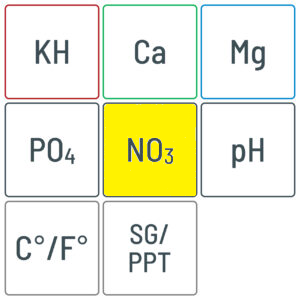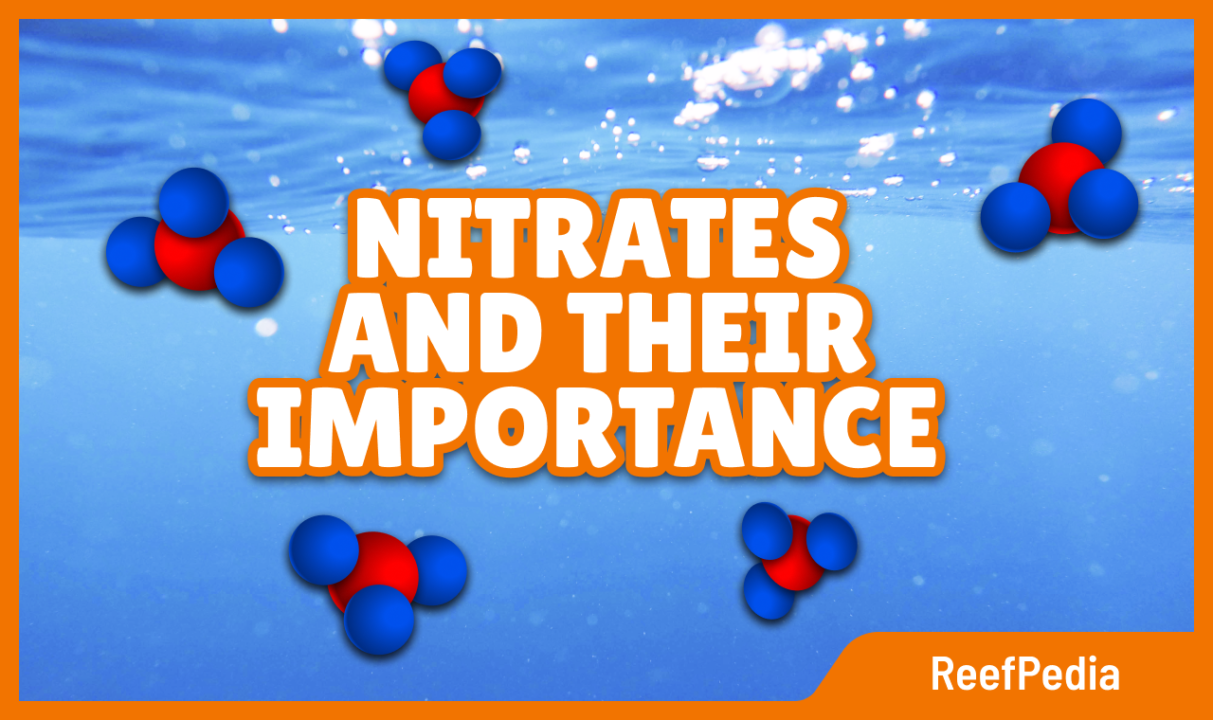Table of Contents
What is nitrogen and what are nitrates?
Nitrogen (N) and nitrates (NO3–) are two different but related topics in saltwater aquarium chemistry. Nitrogen is a chemical element belonging to group 15 of the periodic table and is classified as a non-metal. It makes up over 78% of the volume of air. Nitrogen is part of many compounds, such as ammonia, nitric acid, and organic compounds like amino acids.
Nitrogen in seawater occurs in various forms:
- Nitrogen gas (N2)
It is present in saltwater, but in this form, it is usually unavailable to most organisms.
- Ammonia / ammonium ions (NH3/NH4+)
These are some of the first forms of nitrogen that appear in a saltwater aquarium as a result of the breakdown of organic matter, such as animal waste.
- Nitrites (NO2–)
This is an intermediate form of nitrogen created during the nitrification process. Nitrifying bacteria first convert ammonia into nitrites and then into nitrates.
- Nitrates (NO3–)
Nitrates are the final products of the nitrification process, where nitrifying bacteria convert ammonia into nitrates. They are an important indicator of water quality in a saltwater aquarium, and controlling their levels is crucial for maintaining a healthy environment for fish and other marine organisms.
The mentioned forms of nitrogen are part of the nitrate cycle in a saltwater aquarium. They have different properties, functions, and various impacts on the life in the saltwater aquarium.
Where do nitrates come from in a saltwater aquarium?
The most important sources of nitrates, apart from dedicated supplements for saltwater aquariums, are:
- fish food leftovers – as they decompose, they release nitrates,
- water – when using the so-called tap water, not RO/DI,
- poor quality salt may be contaminated with nitrates,
- dead organic matter,
- a faulty skimmer may not remove enough organic compounds, which promotes the accumulation of nitrates,
- excessive amount of animal excrement,
- the use of preparations whose side effect is the release of nitrates.
The importance of nitrates in a saltwater aquarium
Nitrates are the final product of the nitrogen cycle, which continuously occurs in a saltwater aquarium. Bacteria convert ammonia into nitrites and then into nitrates. Nitrates, like phosphate salts, are an essential part of the natural environment, including seawater. Chemically, nitrate salts in water break down into ions through a process called dissociation, and the form of nitrates is closely dependent on the water’s pH level.
- in water with pH < 6, H2NO3– ions dominate,
- in water with 6 < pH < 8, NO2– ions predominate,
- NO3– ions dominate in water with pH < 8.5.
Similar to phosphates, the pH value in a saltwater aquarium determines the form of nitrates in the water. This is another reason to maintain the proper pH level in a saltwater aquarium.
High pH values (>8) promote the dominance of nitrate ions (NO3–), which are the most stable form of nitrogen, playing a significant role in the marine ecosystem. Nitrates are among the fundamental parameters in saltwater aquarium keeping, forming an essential foundation for maintaining a healthy environment in the saltwater aquarium.

The proper level of nitrates in a saltwater aquarium is important for several reasons:
- Nitrates serve as nutrients and are an important food source for many marine animals.
- Maintaining the appropriate level of nitrates is crucial for preserving balance in the nitrate cycle, which is a significant element of the marine ecosystem. The nitrogen cycle in a saltwater aquarium is a continuous process, and its stability should be safeguarded. You can read more about the impact of chemistry on disrupting the nitrogen cycle in a dedicated article.
How to measure nitrates correctly?
Measuring the nitrate content – NO3– in a saltwater aquarium is important for the aquarium keeper. Monitoring nitrate levels is crucial for maintaining biological stability in the aquarium water. An excess of nitrates can disrupt the biological balance, leading to sudden changes in water parameters that can be harmful to fish and other organisms.
Therefore, it’s important to monitor nitrate levels in saltwater.
There are many methods and products available on the market for accurately determining nitrate levels in saltwater. Each product comes with instructions that, if followed correctly, will allow you to accurately determine this parameter.
The most important products enabling the determination of this parameter include:
- Reagent kits for home nitrate measurement – these are simple-to-use tests, like the NO3 Smart Test Kit from Reef Factory. They allow for quick and relatively accurate determination of nitrate levels in water.

- Photometric devices – more advanced devices, such as Hanna photometers, provide more precise measurements.
- Automatic devices – advanced devices like the Smart Tester from Reef Factory, integrated with the Smart Reef app, offer automatic monitoring of nitrate levels, enabling continuous control and easier adjustment of water parameters.

- Reagent kits for home nitrate measurement – these are simple-to-use tests, like the NO3 Smart Test Kit from Reef Factory. They allow for quick and relatively accurate determination of nitrate levels in water.
Tip: If algae blooms are noticeable in the aquarium and nitrate measurements indicate lower values than expected, it may be that nitrates have been consumed by algae, resulting in less of them in the water. However, this doesn’t necessarily mean that you don’t have an issue with an excess of this parameter.
Correct nitrate content in a saltwater aquarium
Nitrates are one of the most important nutritional components for many marine animals and algae. Therefore, their content should be greater than 0 ppm. The nitrate level should be maintained at a constant level, and this parameter should be adjusted according to the stocking of animals in the aquarium. This parameter directly affects marine fish, among others.
In simpler terms, this parameter should be set within the range of 0.2 – 5 ppm, with the optimal value being 0.5 ppm.

Choosing the optimal nitrate value for your tank depends, among other factors, on the stocking of animals in the aquarium. Helpful in selecting the proportions of C, N, P is the Redfield ratio index, which indicates the appropriate correlation between carbon, nitrogen, and phosphorus.
Threats related to nitrate deficiency in seawater
Too low a nitrate content may cause:
- corals will start starving,
- coral metabolism will slow down,
- some soft corals may begin to disappear,
- coral tissue may also become thinner.
How to respond to nitrate deficiency?
If the nitrate level is below 0.2 ppm, we recommend using products containing this nutrient to balance its level. To ensure a stable nitrate level in a saltwater aquarium, we recommend systematically supplementing this nutrient depending on the coral stocking in your aquarium.
Dangers related to excess nitrates in seawater
Too high a nitrate content may cause:
- there will be a rapid growth of algae,
- the corals will start to turn brown,
- sensitive corals may die,
- there will be problems with the fish.

How to reduce nitrates in a saltwater aquarium?
If the nitrate level exceeds 5 ppm, this should be considered an excess above the recommended level.
Find and eliminate the cause of the problem, and lower the value of this parameter in the water. Perform up to 6 water changes. It’s recommended to replace about 15% of the aquarium water during each change until the recommended value of this parameter is achieved. The replacement water must have the appropriate target salinity level. Use salts with suitable parameters and composition suitable for conducting an ICP test.
You can find more about methods for lowering nitrates in a dedicated article.
Summary
Remember that maintaining the proper nitrate level is just as important as it is for phosphates, which is crucial for the health and balance of the saltwater aquarium ecosystem. Regular monitoring and appropriate corrective actions are necessary to maintain optimal conditions for marine life.
About author

Magdalena Metzler
Privately, I am a mother and a lover of nature and sport. My main interest is quantum chemistry, which hides a whole lot of unsolved mysteries and connections, which is extremely exciting from a scientific point of view.
In my scientific career, I have conducted international projects focused on innovative solutions for many branches of business, e.g. automotive, construction, and now, of course, marine aquaristics.
Working at Reef Factory gave me a passion for marine aquaristics, which I can develop every day, building a chemistry department and creating products that will help aquarists take care of tanks and ensure the highest safety of animals. One of the most exciting memories of working at Reef Factory is the commissioning of the ICP-OES spectrometer, which analyzes the elemental composition of seawater. The method of analysis in ICP is based on an analytical technique, which is a combination of my passion for quantum chemistry and marine aquaristics.
I hope you find my articles on ReefPedia interesting and helpful! Happy reading :))



